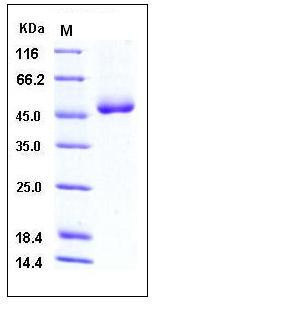Mouse Cathepsin D / CTSD Protein (His Tag)
CatD,CD
- 100ug (NPP3197) Please inquiry
| Catalog Number | P50127-M08H |
|---|---|
| Organism Species | Mouse |
| Host | Human Cells |
| Synonyms | CatD,CD |
| Molecular Weight | The secreted recombinant mouse CTSD pro form consists of 401 amino acids and has a predicted molecular mass of 44.4 kDa. In SDS-PAGE under reducing conditions, the apparent molecular mass of rmCTSD is approximately 48 kDa due to glycosylation. |
| predicted N | Ile 21 |
| SDS-PAGE |  |
| Purity | > 96 % as determined by SDS-PAGE |
| Protein Construction | A DNA sequence encoding the mouse CTSD (NP_034113.1) precursor (Met 1-Leu 410) was expressed with a polyhistidine tag at the C-terminus. |
| Bio-activity | |
| Research Area | Neuroscience |Cell Adhesion Proteins |Membrane Proteins |
| Formulation | Lyophilized from sterile PBS, pH 7.4 1. Normally 5 % - 8 % trehalose, mannitol and 0.01% Tween80 are added as protectants before lyophilization. Specific concentrations are included in the hardcopy of COA. |
| Background | Cathepsin D (CTSD), a well known lysosomal aspartyl protease and belongs to the peptidase C1 family, which is a normal and major component of lysosomes, and is found in almost all cells and tissues of mammals. Its mostly described function is intracellular catabolism in lysosomal compartments, other physiological effect include hormone and antigen processing. Cathepsin D has a specificity similar to but narrower than that of pepsin A. Cathepsin D plays an important role in the degradation of proteins, the generation of bioactive proteins, antigen processing, etc. Among different role in cell physiology, a new function of this enzyme is examined. Cathepsin D is an important regulator of apoptotic pathways in cells. It acts at different stage of intrinsic and extrinsic pathway of apoptosis. In addition, CTSD secreted from human prostate carcinoma cells are responsible for the generation of angiostatin, a potent endogenous inhibitor of angiogenesis, suggesting its contribution to the prevention of tumor growth and angiogenesis-dependent growth of metastases. |
| Reference |
